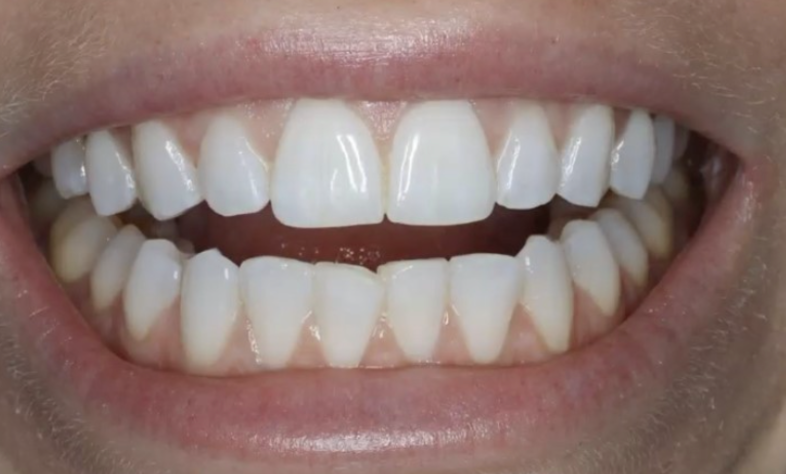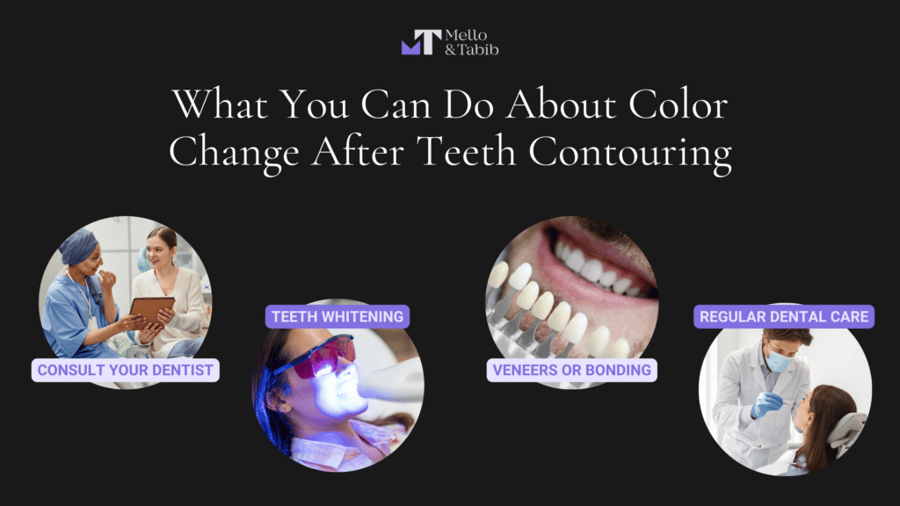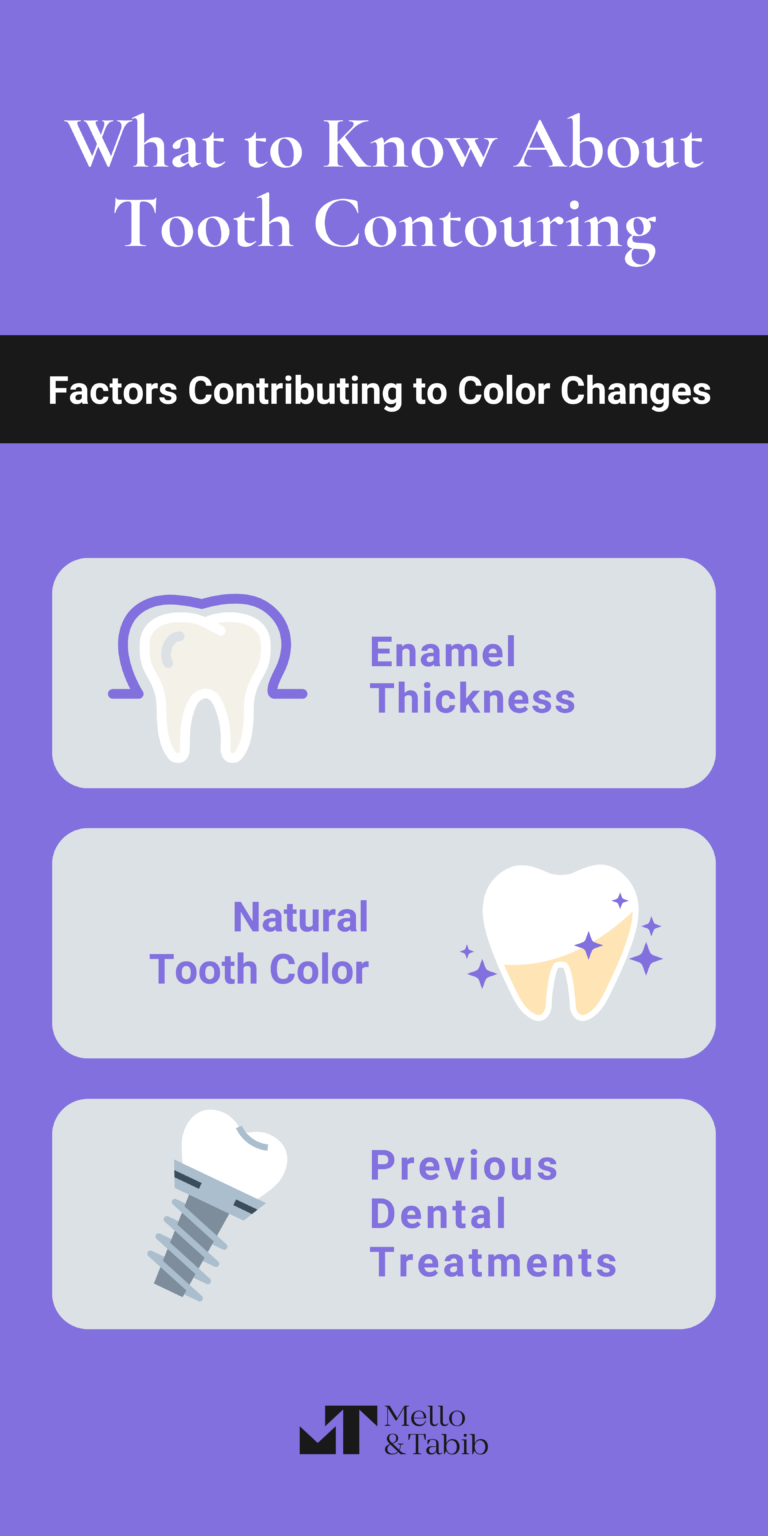I Had Tooth Contouring and My Teeth Have Changed Color, What Do I Do?
January 19th, 2024
4 min read

Tooth contouring, a cosmetic procedure designed to reshape your teeth, can sometimes lead to unexpected changes in tooth color. If you’ve recently had your teeth contoured and noticed a difference in their color, you’re not alone.
At NYC Smile Design, we’ve encountered numerous cases where patients observed color changes post-contouring.
This blog will explain why tooth contouring can affect the color of your teeth and provide guidance on how to handle this situation for a more pleasing outcome, drawing from our extensive experience in addressing such concerns.
What is Tooth Contouring?
Tooth contouring, sometimes known as enamel shaping, is a delicate cosmetic dental procedure focused on subtly altering the shape or size of your teeth. This method involves the careful removal of a minimal amount of enamel, which is the outermost protective layer of the teeth. The primary goal of tooth contouring is to correct minor dental imperfections, such as small overlaps, minor chips, or slightly irregular shapes of the teeth, thereby enhancing the aesthetic appeal of your smile.
Enamel, apart from safeguarding your teeth, plays a crucial role in determining their overall appearance, including their color and sheen. When the process of contouring is undertaken, a portion of this enamel is gently scraped off. This action may sometimes reveal the dentin layer beneath, which typically has a yellower or darker shade than the enamel’s bright white surface. Consequently, this can lead to a noticeable change in the tooth’s color, especially if the dentin’s natural color is significantly different.
Tooth contouring is often a swift and comfortable procedure, usually requiring no anesthesia, and can provide immediate improvements to your smile. It stands out as a conservative and budget-friendly alternative compared to more extensive cosmetic dental treatments. However, it’s essential to approach tooth contouring with a clear understanding that it’s best suited for making subtle aesthetic enhancements. If you’re contemplating this procedure, it’s important to have an in-depth discussion with your dentist. They can evaluate how well this treatment aligns with your dental objectives and how it may impact the overall look and color of your teeth.

What Can You Do About It?
If you’re concerned about the change in color after tooth contouring, the first step is to consult with your dentist. They can evaluate the extent of the color change and recommend appropriate solutions, whether it be professional teeth whitening or considering options like veneers for a more uniform appearance.
Teeth Whitening
Professional teeth whitening can sometimes balance the color differences and be an easy solution to help you achieve your dream smile. However, it’s important to discuss with your dentist whether this is a suitable option for you. Because your enamel could be thinner, you may experience teeth sensitivity after whitening.
Additionally, it’s important to remember that tooth contouring may expose the dentin, the layer beneath the enamel, which is naturally less white. If the dentin is more visible, it can affect the overall color of your teeth, making them appear yellower. In such cases, regular teeth whitening treatments might not be as effective in achieving the desired level of whiteness. If professional whitening isn’t suitable due to sensitivity concerns or the visibility of dentin, veneers could be an alternative option.

Veneers or Bonding
In cases where whitening isn’t effective, your dentist might suggest veneers or bonding. These treatments can cover the tooth’s surface, offering a uniform color and appearance.
Veneers are crafted from porcelain or composite resin materials and are matched to the desired shade of whiteness, ensuring they blend seamlessly with your natural teeth or provide a complete makeover to your smile. Bonding, on the other hand, involves applying a tooth-colored resin material to the teeth. Both not only change the color of your teeth but also enhance their shape and size, if necessary, providing a complete smile transformation.
Regular Dental Care
Maintaining good oral hygiene and regular dental check-ups can help preserve the color and health of your teeth post-contouring.

Factors Contributing to Color Changes
Understanding these factors can help you have a clearer picture of what to expect from tooth contouring, especially regarding potential changes in tooth color. If you’re considering this procedure, it’s a good idea to discuss these aspects with your dentist.
1. Enamel Thickness
One of the key factors that can affect tooth color after contouring is the thickness of your enamel. Enamel is the hard, protective outer layer of your teeth. Its thickness varies from one person to another. In some cases, people might have naturally thinner enamel. When tooth contouring is done, and some of this enamel is removed, it can make the underlying layer, called dentin, more visible. Dentin has a different color – usually yellowish – which can become more noticeable after the contouring procedure, especially if the enamel is thin.
2. Natural Tooth Color
It’s also important to remember that teeth naturally come in a range of colors. They’re not all the same shade of white. The dentin, which lies beneath the enamel, can be yellow, gray, or even a bit brown. Everyone’s teeth are unique, and these natural color variations in your dentin will become more apparent once the enamel is contoured. If your dentin is on the darker side, this might be more noticeable after contouring.
3. Previous Dental Treatments
Your history of dental treatments can also play a role in color changes after tooth contouring. For example, if you have had dental fillings, crowns, or bonding, these might not match your natural tooth color exactly. When contouring is done, especially near or around these treatments, it can lead to uneven coloring. The contoured area might look different from the rest of the tooth or from your other teeth, particularly if you’ve had treatments that involve different materials or shades.

Conclusion: Finding the Right Solution
Noticing a change in tooth color after contouring can be surprising, but there are several ways to address this issue. Understanding why these changes occur is the first step toward finding a solution. It’s crucial to discuss your concerns and options with a dental professional, as they can provide personalized advice and treatment options tailored to your specific situation. Whether it’s through professional teeth whitening, veneers, bonding, or other treatments, there are various paths to restoring or even enhancing the color of your teeth post-contouring.
If you’ve experienced a change in tooth color following contouring, we highly recommend scheduling a consultation with your dentist. They can conduct a thorough examination and suggest the most effective course of action. For those in the vicinity, you are welcome to schedule a consultation at NYC Smile Design. Our team is well equipped with the expertise and technology to assess your situation and recommend treatments that align with your dental health and aesthetic goals.
Remember, every smile is unique, and finding the best approach for your teeth is key to maintaining a confident and radiant smile. Taking the time to consult with a dental professional is a valuable step in ensuring that your smile not only looks great but also reflects your overall oral health and well-being.
Topics:

